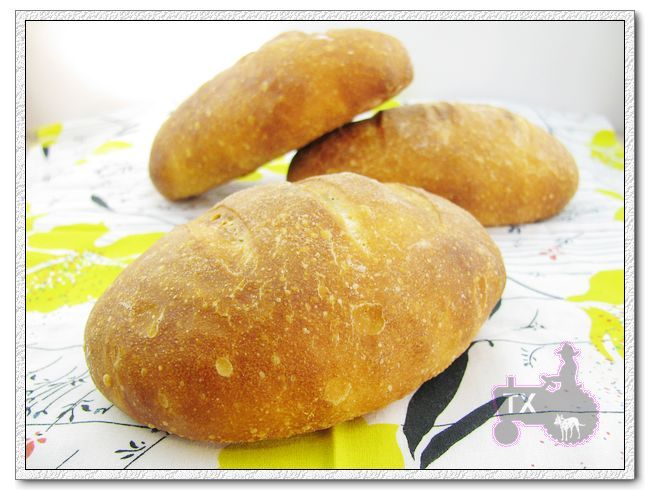
This bread is inspired by a Japanses baking book (translated into Chinese since I don't read Japanese at all):《日本人气面包店天然酵母的美味面包物语》.Japan has a very exciting and innovative artisan bread baking scene, which heavily influences Taiwan, Hongkong, and most recently China. I am originally from China (live in Texas now), still keep a baking blog in Chinese (http://blog.sina.com.cn/txfarmerying), and am pretty closely connected to the ever growing Chinese baking community, so I am lucky enough to have access to some Japanese/Chinese bread baking books/resources.
This bread is interesting in that it combines the classic lean sourdough bread and Asian style sweet buns in an unique way (typical of Japanese baking, which is very inventive and exciting). On the outside, it's a very typical sourdough baguette dough, on the inside, a sweet paste filling is first wrapped in a crepe, then wrapped in the dough, the bun is then baked on stone with steam just like a lean sourdough bread. In each bite, you get 3 different texture and flavor layered together: crusty and chewy baguette, soft crepe dough, then melt in your mouth sweet filling, unlike anything I've tried before! Since the recipes in the book are from a big-ish bakery in Japan, it's not practical to follow it in my US home kitchen, so I simply took the concept, and used my own formulas for the components, with satisfactory results.

First, make the crepes, the following formula makes 6 to 7 crepes in my 10 inch pan, I only needed 2 for the buns, ate the rest with some nutella and bananas.
cake flour, 90g
eggs, 2
sugar, 10g
milk, 180ML
butter, 30g, melted
- mix everything together, cover and rest at room temperature for 1 hour or more, pour 1/4cup of mixture into a lightly oiled pan, fry on both sides until done.

Now the buns, the dough is a typical baguette dough @ about 70% hydration, the following forumla makes only 4 buns (each around 140g), mostly because it's the last bit of my chestnut paste.
starter, 85g (100% hydration)
instant yeast, 1/4tsp
salt, 4.7g
bread flour, 190g
water, 120g
chestnut paste (lightly sweetened), 120g
bittersweet chocolate, 40g, chopped (I used baking chocolate pieces)
crepes, 2 (from recipe above)
- mix starter, flour, water, autolyse for 30min
- add salt and yeast, knead until gluten starts to develope. 3 minutes in my KA at medium speed.
- cover and fermentate at room temperature for 2.5 hours, with S&F at 30, 60, and 90 minutes. dough is very elastic and beautiful by the third fold, though still pretty wet.
- divide into 4 parts, each about 100g. round and rest for 20 minutes.
- take HALF of the crepe, wrap 30g of chestnut paste and 10g of chocolate inside


- take a piece of dough, press flat, and wrap the filled crepe inside, seal the seam, roll into a small batard

- slash on top, take care not of cut the crepe layer

- proof for 1.5 hour @ room temperature
- bake on stone with steam, 450F, 30 minutes. I preheated to 550F, decreased to 450F after steaming. At 10 minutes, I took out the steam pan.

Makes a great snack or dessert. There are a lot more innovative recipes in that book, can't wait to try more. My last white wine chestnut sourdough also uses the same ingredients, yet it tastes vastly different from this bread, very interesting.

